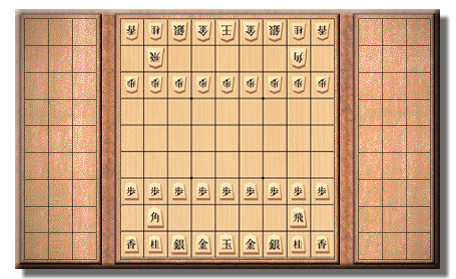|

“The
game in its present form was played as early as the 16th century”
Japanese form of
Chess, the history of which is also obscure (nebulous).
Traditionally it is thought to have originated in India
and to have been transmitted to Japan via China and
Korea. Shogi like traditional Chess is played on a
squared board with pieces of varying powers, and the
object is checkmate of the opposing King. It is played on a square board of 9 x 9 or, 81 cells with pieces of differing powers.
Two distinctive features, however, differentiate Shogi from European
Chess: 1. Captured pieces are not dead but may be
pointed in the opposite direction and replayed as part
of your own or your opponents forces. 2. The minor
pieces (Japanese Pawns) capture one cell straight ahead.

Each player has 20 pieces, which oppose each other on a board composed of 9 horizontal and 9 vertical rows. There are 9 minor pieces (Fu), a RO (Hisha), a BS (Kaku), one King (Osho), 2 Gold Generals (Kinsho), 2 Silver Generals (Ginsho), 2 JKs (Keima), and 2 Lance (Kyosha).
The pieces vary in power of movement, roughly (and I mean very roughly)
corresponding to those of western Chess. Bishop and Rook
oppose each other diagonally. The traditional Japanese
pieces are flat, blunt, and taper slightly toward the
front. Each bear Japanese identifying characters. All
pieces except the King and gold Generals may be promoted on entering the last
3 ranks of enemy territory.
|
Japanese Chess Shogi - Monogram and
names |
|
9 |
Samuri Fu |
|
1 |
Rook
Hisha |
|
1 |
Bishop Kaku |
|
1 |
King
Osho |
|
2 |
Gold
Generals Kinsho |
|
2 |
Silver Generals Ginsho |
|
2 |
Knights Keima |
|
2 |
Spearmen Kyosha |
|
( Total of 20 pieces per side ) |
The promoted rank of each major piece is marked on the reverse, most become Gold Generals (JGs). Captured pieces are held at reserve bases until they are needed on the field again. They retain their original rank and may be reentered on any unoccupied cell. If entered within your opponents territory, they qualify for promotion on making their first move.
|